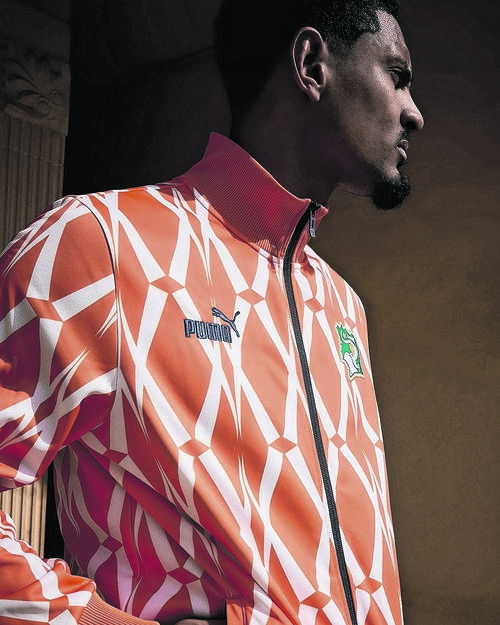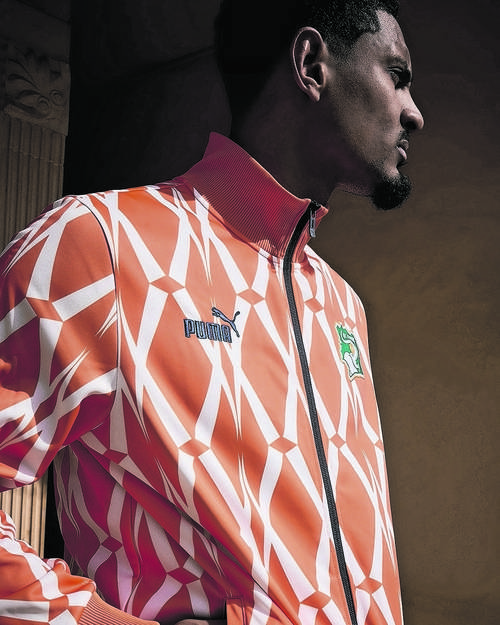

Football shirts are generally made of polyester. But they also contain power. To wear the replica kit of your beloved club or national team is to transmit a high wattage of meaning.
The shirt says loyalty, love, community, identity, difference, defiance. It can even express rueful sadness or a dark and self-effacing sense of humour, if the team in question is awful enough. Football shirts invite salutes, chats, jokes, debates. If you’re up for a fight, a shirt can get the brawl rolling. If you’re up for a hug, your shirt can arrange it for you.
This is why millions of rational human beings will happily cough up as much as €100 for a garish, plasticky T-shirt that doesn’t breathe too well. And this is why the three biggest sportswear manufacturers typically generate billions of euro in profit and frequently invest tens of millions in the right to supply the kit for a leading national team.
Adidas is the world’s biggest spender, lobbing a reported €60 million euros a year at the German football association for the Mannschaft contract, along with billions more on hundreds of other sponsorships.
And whenever the Africa Cup of Nations (Afcon) finals roll around, the kit wars get hot, not least because African kits have long been a canvas for adventurous design.
Cameroon’s audaciously sleeveless 2002 World Cup shirt by Puma was swiftly banned by Fifa just days into the tournament — and then quickly tweaked into legality with the addition of tight black short sleeves.
Nigeria’s enchanting 2018 World Cup kit by Nike — featuring a rhythmic rain of blurry chevrons — arguably set the global standard for shirt evolution, echoing the groundbreaking geometric energy of Adidas’ Euro 1988 Netherlands kit.
This year’s tournament, which runs until 11 February in Côte d’Ivoire, doesn’t feature any instant modern classics — but there are some genuinely snazzy efforts in the mix.
Puma, which has dominated the African national-team market for many years, is providing six of the 24 kits — and arguably six of the eight strongest sides in the draw: Morocco, Egypt, Côte d’Ivoire, Senegal and Ghana. All six designs are elegantly conservative, opting for classic forms and detailing, rather than graphic explosions or figuration.

The Puma shirts honour recent successes and classic design signatures: Morocco’s home kit reprises the green band across the red field from their glorious showing at Qatar 2022, while Afcon champions Senegal keep the chevron “flag” emblazoned across the chest.
Other Puma efforts, especially away versions, echo each other with a vertical rectangular motif extending down the torso. The Ivorian Elephants’ new shade of orange is more muted — but a kit doesn’t have to give you a migraine to be nice.
The juggernauts of global kit sponsorship, Adidas and Nike, have a low Afcon profile again this year, sending only one kit apiece to the finals.
Adidas’ Algerian home shirt is nicely jazzy, with three blurry stripes down the left side. And Nike’s Super Eagles design, while it can’t hold a candle to its 2018 ancestor, is at least assertive and interesting — a teeming field of tropical foliage echoing batik textiles, with a centrepiece of an oddly uneagly-looking eagle.
The white away kit with green shoulder detailing is a far stronger mash-up of vernacular references and futuristic cool.
So, the big three suppliers have chosen to concentrate their spend on the Afcon heavyweights, whose kits sell more units to bigger populations and generate more brand recognition and contribute to the sponsor’s association with winners.
For the other 16 teams in the draw, the compensation for being snubbed by the big three is the chance to let an African or African-linked sportswear firm cut loose and do something really fun and progressive.
For example, many footie fashion fundis consider Mali’s 2023 kit, by the small France-based outfit Airness, to be the pick of the field at this tournament.
Airness founder Malamine Koné is a Malian-French entrepreneur who arrived in Paris when he was 10. He created his own sportswear label soon after his boxing career was cut short by a car crash injury in 1995.
Airness began audaciously, picking up plum Ligue 1 contracts and a deal with English Premier League side Fulham but Koné soon found competing consistently with the giants as a small startup is hellishly difficult.
Economies of scale are not on your side, so you can’t afford to cross-subsidise your sponsorships or muster the ready cash to bid for club deals that may not pay off in sales.
Nowadays, Airness is a niche label — hip, distinctive and rarely seen on footballers in action.
But Airness and the Mali football association remain loyal to each other and this Afcon home shirt is a corker, dominated by a swooping eagle, its outstretched talons ready to sink into the viewer’s cheeks.
The bird’s wings are textured with Roy Lichtenstein-style dots, with two sets of bloody talon slashes adorning either hip for an added touch of airborne violence.

The whole design is fun and wild and comic-bookish — the creators don’t give a hoot about being understatedly elegant in the way that the big three’s design teams tend to.
Two other competing associations have also chosen local kit makers with great results. Burkina Faso are wearing a fine design by Burkinabe firm Tovio, featuring a diagonal jagged-edged sash motif.
And Tanzania’s Taifa Stars are clad in a simple, loud, blue-with-gold-trim affair by Tanzanian brand Sandaland, which also equips the Tanzanian superclub Simba SC.
The shirt has echoes of the early nineties Wimbledon FC “Crazy Gang” kit, which may or may not inspire a campaign defined by crude long balls and legally actionable tackles.
Shirt sponsorship contract numbers are rarely revealed by either partner but it’s safe to assume going local involves leaving some money on the table, since the midranking European brands, such as Umbro, Macron and Le Coq Sportif (which kits out Bafana Bafana) tend to pay associations nicely, if not nearly as lavishly as the big three brands do.
And as for a green-horned Bafana, this year’s kit is lovely. It has a neat retro energy. Could it rewind the team’s cultural clock to unlock a new era of nineties-flavoured Bafana excellence? The answer is no. A kit design might contain power but not on the pitch.
CAF doesn’t give a continental how you make your millions
Afcon is steeped in post-colonial pan-Africanism. The tournament began in 1957, the year in which Ghana’s independence foretold dozens of other liberations.
Apartheid South Africa was barred from that first event, a full four years before global sporting bodies began to bounce Pretoria from competition. Later, Nigeria’s Sani Abacha-era Super Eagles were barred from the 1996 edition.
While the no-tyrants, no-racists policy has been far from consistently applied, the Afcon story is indivisible from the pursuit of African sovereignty, solidarity and progress.
But it’s hard to discern this history from the Confederation of African Football’s (CAF) elite list of tournament partners: French oil giant TotalEnergies, Russian sports betting firm 1XBet, French telecoms giant Orange, US credit card giant Visa and Unilever-owned deodorant brand Rexona.
So, the brand message the tournament seems to be sending is something like this: 1. Use your credit card to waste your income on gambling. 2. Break into a cold sweat. 3. Spray your armpits. 4. Text your partner to ask for petrol money.
Jokes aside, it’s not a great look for Africa’s football showcase to be flogging its premium real estate to dodgy bookies and planet-wrecking oil barons.
We can’t really blame those sponsors themselves for besmirching the Afcon. Mammon’s gonna mammon, after all. And if you own a big brand, destructive or positive, and want to speak loudly to an even bigger audience, then football is the biggest loudhailer on earth.

No other form of popular culture has the same intensity and scale of engagement, with billions of eyes and imaginations converging on an endless flow of drama.
In Europe, football is a bigger industry than publishing and cinema. And in India, China and the US, traditionally not football-crazy nations, the game is increasingly the obsession of cosmopolitan, educated youth — precisely the people most brands want to seduce.
No wonder then that fossil-powered princes, AI-powered casinos, hedge fund barons and tinpot autocrats are sportswashing their sins so lustily — with the help of any stars or clubs willing to trade their integrity for a payday.
Elite football is being avidly consumed by those ravenous entities that consume the rest of us — by polluting and hoodwinking us.
Of course, it doesn’t have to be this way. Football’s power to reach people can empower potently positive brands.
Antiracism campaigns such as “No Room For Racism” have deployed the game’s platform to detoxify the game — it’s too soon to know how effectively.
Back in their financial heyday, Barcelona gave Unicef a free shirt ad for an entire season. (Nowadays, the Catalans have to make do with punting the Rolling Stones and Drake courtesy of Spotify.)
Gordon Cook, co-founder and school navigator for Vega School of Brand Leadership in Joburg, notes that truly successful sport sponsorship relies on the power and consistency of a team’s own brand.
Colours and crests carry brand power, but so does success, and so does a certain style — Barcelona’s tiki-taka style of playing, for example — or a distinctive team ethic.
The World Cup-winning Bok side embody an ethic of collective responsibility and service that makes them a sponsor’s dream.
Back when Samsung was rising rapidly as an electronics giant, it struck gold by backing Chelsea in its equally rapid rise to greatness through the noughties.
Emirates airline has hit the jackpot with Real Madrid, while Standard & Chartered have done likewise with Klopp-era Liverpool.
Adidas will always be indivisible from the German national team — both brands being steeped in clean, functional brilliance. The virtues of the partners speak as one organism.
But one’s virtues can go very quiet when somebody in a very clean suit puts a pile of very dirty money on one’s desk. Ask CAF. — Carlos Amato
The battle for Africa’s national shirt market has taken a new turn, with some of the raciest designs coming from continental brands





